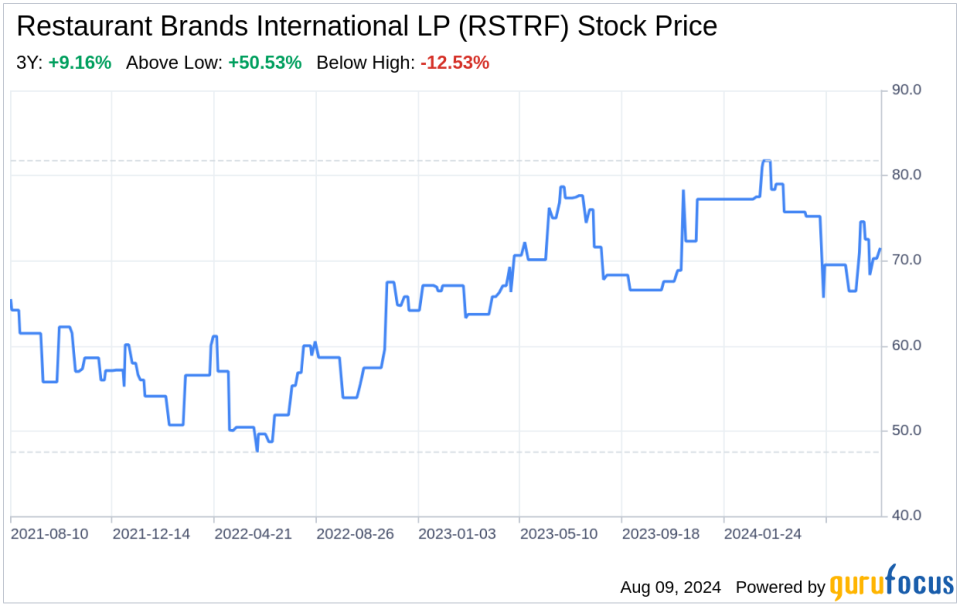Decoding Restaurant Brands International LP (RSTRF): A Strategic SWOT Insight
Robust brand portfolio with Tim Hortons, Burger King, Popeyes, and Firehouse Subs driving growth.
Strategic acquisitions and international expansion presenting new opportunities.
Challenges include intense competition and potential legal contingencies.
Financial performance reflects strong sales growth, but increased debt levels warrant attention.
On August 8, 2024, Restaurant Brands International LP (RSTRF) filed its 10-Q report, providing a detailed look into its financial performance and strategic positioning. As a premier quick-service restaurant operator with a significant global presence, RSTRF oversees a diverse portfolio of brands including Tim Hortons, Burger King, Popeyes, and Firehouse Subs. The company's financial tables reveal a complex landscape of robust sales growth, strategic acquisitions, and a focus on franchising. This SWOT analysis delves into the strengths, weaknesses, opportunities, and threats as presented in the latest SEC filing, offering investors a comprehensive view of RSTRF's potential trajectory.

Strengths
Brand Portfolio and Market Presence: Restaurant Brands International LP (RSTRF) boasts a powerful suite of brands, each with a distinctive identity and loyal customer base. Tim Hortons, known for its coffee and baked goods, and Burger King, with its iconic Whopper, are household names. Popeyes has carved out a niche with its New Orleans-style chicken, while Firehouse Subs adds a specialized offering to the mix. The diversity within RSTRF's portfolio allows for cross-brand synergies and a broad market appeal. This is evidenced by the company's expansive global footprint, with over 31,000 restaurants operating in more than 120 countries as of June 30, 2024. The strength of its brand portfolio is a key differentiator in the competitive quick-service restaurant industry.
Franchising Model and Financial Performance: RSTRF's franchising model is a cornerstone of its financial strength. With approximately 95% of its restaurants franchised as of the reporting date, the company benefits from a steady stream of franchise and property revenues, which include royalties and fees. This model provides a lower-risk revenue stream and has contributed to RSTRF's significant system-wide sales growth. The financial tables from the 10-Q filing highlight the company's ability to generate substantial revenues while maintaining a lean operational structure. Moreover, the franchising approach facilitates rapid expansion and market penetration without the capital expenditures associated with company-owned restaurants.
Weaknesses
Debt Levels and Financial Obligations: Despite its strong revenue streams, Restaurant Brands International LP (RSTRF) carries a substantial amount of debt. The 10-Q filing outlines various credit agreements and senior notes, indicating a complex debt structure that includes first and second lien senior notes with varying maturity dates and interest rates. As of June 30, 2024, the company's condensed consolidating balance sheets show significant long-term debt, which could pose a risk to financial stability in adverse market conditions. The debt obligations require careful management to ensure long-term sustainability and may limit the company's financial flexibility.
Legal Contingencies and Market Risks: RSTRF is subject to various legal proceedings and market risks that could impact its operations. The 10-Q filing mentions ongoing litigation, including class action complaints and shareholder disputes, which could result in financial liabilities or damage the company's reputation. Additionally, the company faces market risks such as foreign exchange volatility, which can affect the value of international revenues. These weaknesses necessitate a proactive risk management strategy to mitigate potential adverse effects on the company's financial health and brand image.
Opportunities
Strategic Acquisitions and International Expansion: Restaurant Brands International LP (RSTRF) has demonstrated a strategic approach to growth through acquisitions, as seen with the recent Carrols Restaurant Group and PLK China acquisitions. These moves not only expand the company's operational footprint but also provide new revenue streams and market opportunities. The inclusion of these acquisitions in the company's financial statements starting from the second quarter of 2024 indicates a forward-looking growth strategy. Furthermore, the international segment of RSTRF's operations presents significant opportunities for expansion, especially in emerging markets where the demand for quick-service restaurants is growing.
Product Innovation and Digital Engagement: RSTRF has the opportunity to leverage its strong brand presence to drive product innovation and enhance customer engagement. The company can capitalize on trends such as plant-based menus and health-conscious offerings to attract new customer segments. Additionally, investing in digital platforms and mobile ordering can improve the customer experience and operational efficiency. These initiatives can lead to increased customer loyalty and sales growth, positioning RSTRF favorably in a rapidly evolving industry.
Threats
Intense Competition and Changing Consumer Preferences: The quick-service restaurant industry is highly competitive, with numerous players vying for market share. Restaurant Brands International LP (RSTRF) faces competition from both established chains and emerging brands. The company must continuously innovate and adapt to changing consumer preferences, such as the shift towards healthier food options and sustainability concerns. Failure to respond effectively to these trends could result in a loss of market share and reduced profitability.
Economic Uncertainty and Regulatory Changes: Economic fluctuations and regulatory changes pose threats to RSTRF's operations. Macroeconomic factors such as inflation, unemployment rates, and commodity prices can affect consumer spending and operational costs. Additionally, regulatory changes, including minimum wage increases and food safety standards, can impact the company's cost structure and profitability. RSTRF must navigate these uncertainties while maintaining its competitive edge and operational efficiency.
In conclusion, Restaurant Brands International LP (RSTRF) exhibits a strong brand portfolio and franchising model that underpin its financial performance. However,
This article, generated by GuruFocus, is designed to provide general insights and is not tailored financial advice. Our commentary is rooted in historical data and analyst projections, utilizing an impartial methodology, and is not intended to serve as specific investment guidance. It does not formulate a recommendation to purchase or divest any stock and does not consider individual investment objectives or financial circumstances. Our objective is to deliver long-term, fundamental data-driven analysis. Be aware that our analysis might not incorporate the most recent, price-sensitive company announcements or qualitative information. GuruFocus holds no position in the stocks mentioned herein.
This article first appeared on GuruFocus.

 Yahoo Finance
Yahoo Finance 